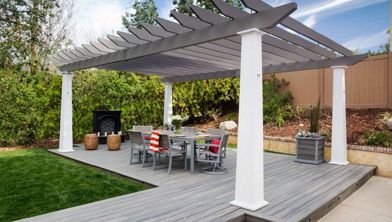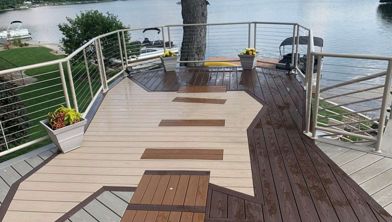How to Draw Your Own Plans for a Deck Permit
Discover how you can create a deck plan for your ideal outdoor space with a little help from Trex.
Before starting any deck build, you'll need a building permit, whether you plan to build the deck yourself or hire a professional contractor. This permit ensures your new deck is built to meet code standards for structural integrity and safety. To secure a permit, you will need to submit deck plans.
The good news is you don’t need a degree in architecture to draw deck plans for a building permit. Many homeowners choose to create their own deck plans. However, it is important to approach this task carefully to ensure that your plans comply with local regulations. In this article, you will gain important information and tips on how to draw plans for a deck permit.
Can You Draw Your Own Deck Plans for a Permit?
A great deck starts with a great plan. Your plan can be as rudimentary as a sketch done with pencil, measuring tape and graphing paper or a more elaborate rendering using computer-aided design (CAD) tools. Whichever route you take, it is key to ensure your plan is to scale. For example, every 1/4" on your design could relate to 1' on the actual deck. It really comes down to what is required by your local building department.
There are a variety of online tools available to help homeowners bring their deck visions to life. From template deck plans to deck design programs, there are lots of great resources out there to help you feel like the Mies Van der Rohe of your deck project.
Ultimately, when it comes to deck drawings for permit, here’s what building departments are looking for:
- Compliance: Residential deck plans for permits are used to make sure the deck design complies with all local building codes, zoning regulations and safety standards. Along with those compliances being met, authorities are also looking for load-bearing capacity, setback distances and railing heights. All these standards vary based on your location.
- Clarity: A deck site plan provides clear and precise visual representations of the proposed layout, dimensions and materials. This ultimately gives permitting offices the project scope and a sense for the overall impact on the surrounding environment.
- Documentation: Any deck plans sent to the permitting office are used as documentation, making it easier to track changes and modification during construction.
Use the Trex Deck Designer Tool to Design Your Own Deck Plans
To help homeowners with drawing deck plans, Trex offers a variety of tools from an AR Deck Visualizer app to template deck plans, materials and cost calculators, and a deck design program that enables users of virtually any level of experience to put together professional-quality deck plans that can be used to obtain building permits. The Trex Deck Designer is a helpful resource for creating deck plans for permit. The intuitive interface allows individuals to experiment with different layouts and has the ability to generate 3D renderings and detailed materials lists, which are actively itemized for cost estimation and planning. The tool also aides in code compliance by providing accurate design documentation that can be submitted to authorities to ensure a more efficient permitting process.
In Conclusion
Understanding how to draw deck plans for a permit is an important step in turning your vision into an outdoor space that family and friends will enjoy for years and decades to come. And while drawing your own deck plans is possible, it’s essential to recognize your own limitations. If you’re uncertain about any aspect of the design or if your deck is more complex, consider consulting with an architect, structural engineer or a professional deck contractor. Their expertise can help ensure the safety and compliance of your project. To locate an expert in your area, use the Find a Builder tool.
What is Required for Deck Drawings for a Permit?
Drawing deck plans doesn’t have to be complicated, but your plans must comply with local building codes. To find out what is required to apply for a deck permit, contact your local building department to obtain a copy of the codes and regulations specific to your area. Many municipalities offer information packets that outline the items that need to be submitted at the time of application. Some even offer easy-to-use deck templates that guide you through the required information and steps for drawing residential deck plans for permit.
To issue a decking permit, a permitting office typically needs the following:
- A completed application (which can be found either on the building department’s website or at their office)
- At least two sets of building plans
- Multiple copies of the site plan drawn to scale
- Contractor license (this isn’t required if you’re building the deck yourself)
- Payment for the decking permit and review fees
Once the above information and payment have been submitted, it can take several weeks to get everything approved, so be sure to account for this process in your project timeline.
How to Draw Deck Plans for a Deck Permit
When drawing deck plans for permits, it’s imperative to include certain details to show a comprehensive overview of the project. The most effective deck plans for building permits clearly show that the finished deck will be compliant with local building codes and zoning regulations. A complete set of deck building plans will include two elements – site plans and elevation plans.
Site Plans
A site plan is a set of drawings that function as a map of the building site. A site plan of the property can be obtained through different measures, such as local building departments, city records, or having a company do it for you. If the site plan is obtainable from the municipality, the deck plan can be included to illustrate its location and dimensions relative to the property lines. This plan should be drawn to scale and include the following details:
- Property Boundaries: Mark the deck’s position relative to property lines, neighboring structures, and setback requirements.
- Deck Dimensions: Provide exact measurements for the deck’s length, width, height, and elevation from the ground. Include precise dimensions for substructure elements like footings, beams, joists, and posts. Here's a breakdown of all the parts of a deck.
- Existing Structures: Identify locations of the house, garage, pool, and any major structures, such as pergolas, fences, or outbuildings.
- Access Points: Indicate all access points on the deck, including stairs, ramps, or other entry and exit methods.
- Utilities: Identify the locations of water, gas, and electric lines, as well as any well and septic systems. This facilitates future customization of your deck.
To ensure compliance with local regulations, provide construction details that illustrate how the deck will be built. Include:
How to Draw Elevation Plans for a Deck Permit
When applying for a deck permit, you will also need to submit an elevation plan. This blueprint-style drawing provides a view of the planned deck from the side and shows the heights of the various components, their vertical arrangements, and other information not easily conveyed on the site plan.
Elevation Plans
As far as how to draw a blueprint for a deck, a good elevation plan should include the following:
- Initial assessment – Determine the desired height and placement of the deck. Be sure to consider the existing topography, nearby structures, and any potential obstacles, as it’s important to address them before construction begins.
- Elevation sketch – Include information about the deck’s height from the ground, the vertical dimensions of foundational components (footings, beams, joists, posts, etc.) and additional features like stairs, railings and attached structures.
- Annotations – Label all the elements on the elevation plan, including dimensions, materials to be used and any other relevant information.
The details required for the site and elevation plans may seem daunting, but they achieve the goal of providing as much information as possible to the permitting office, as well as a potential contractor, and can help streamline the approval and building process.
Is there an App to Build a Deck?
Trex offers a variety of free deck design tools to kick-start your deck project. From designing your deck to picking materials to budget cost, these tools offer an assortment of features that will allow you to see how your deck will look once complete.
Trex AR Deck Visualizer App
With the use of your smartphone and camera, you can visualize your new deck in no time with the Trex AR Deck Visualizer App. Augmented reality technology allows you to experiment with different deck frame layouts, color options, and railing designs while overlaying them into your own garden space in real-time. This innovative technology gives you instant access to countless deck designs without leaving the comfort of your own home.
Trex Deck Designer
Experiment with layouts, visualize your ideas in 3D, and create one-of-a-kind designs right from your computer with the Trex Deck Designer. Once you have fine-tuned your design, create a material shopping list and download your blueprints for your contractors and local building departments.
Downloadable Deck Plans
Get your deck project started effortlessly with our pre-made, designer-curated deck plans designed to match the most popular styles. These tried-and-true plans are perfect for any home, offering a head start with styles and layouts that work beautifully in a variety of spaces. Choose a plan that fits your vision, then customize it with ease—adjust dimensions, and materials, or add features like steps, staircases, and raised levels. With these expertly crafted designs, creating your dream deck has never been easier.
Decking Material Cost Calculator
The Trex Cost Calculator is a helpful tool for estimating the cost of your decking materials. You can choose between two options: a quick estimate based on the general size and details of your project or a more detailed version that factors in your specific material selections. Please note this tool provides an estimate for materials only—labor and installation costs are not included. It’s a great way to get an idea of what to expect as you start planning your deck project.
Create Detailed Deck Plans
Creating deck plans for a permit is a crucial step in transforming your vision into a lasting outdoor space for family and friends. While you can draft your own plans, it's important to be aware of your limitations. If you're unsure about any design elements or if your deck is complex, consult with an architect, structural engineer, or professional deck contractor. Their expertise ensures your project’s safety and compliance. Find local experts using the Find a Builder tool.
If you're ready to upgrade your outdoor space but don't know where to start, get some inspiration from these trending ideas:
13 Irresistible Upgrades for Your Outdoor Living Space
13 Ideas to Transform Your Outdoor Space with The Trex® Outdoor Kitchens Collection
Designing a Dream Deck—10 Deck Features You Can’t Do Without
This content was partially or fully generated by AI and has been reviewed by our team to ensure accuracy and relevance.







































